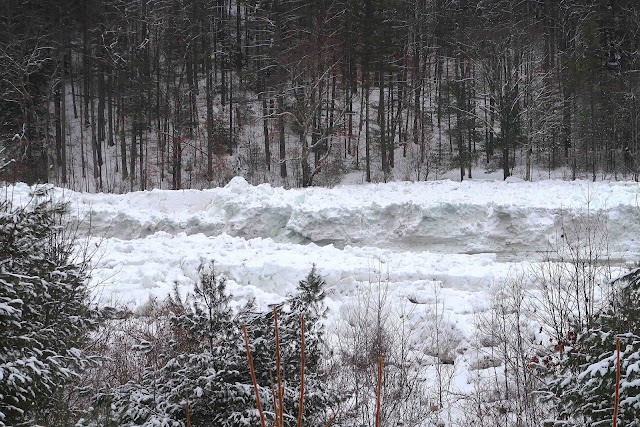The regional news this past week was full of stories about ice jams on the Hudson that caused record flooding and washed-out roads along the river near Warrensburg, about 30 miles north of Saratoga Springs. I had just visited that area on January 3, noting the buildup of frazil ice due to bitter cold temperatures (see my post for January 4). The ice heaps were significant then, but nothing like they became in the weeks that followed, which brought melting temperatures and pouring rain to unleash the destructive power of those monumental ice heaps and the roaring river that caused and carried them. Having gasped at the newspaper photos and website videos of the river's ferocity and subsequent damage, I decided I needed to go have a look for myself. Heading north out of Warrensburg along Golf Course Road, I began to see what remained of the immensity of the ice build-up, noticeable in the monumental heaps of jumbled ice pressing against the guard rails and pushing over roadside trees. Normally, the surface of the river lies about 15 feet below the road.
I was glad my friend Evelyn Greene was free to join me on Friday to go survey the sites of maximum damage. For several decades, Evelyn has been studying this section of the river and its distinctive ice called "frazil," which forms in turbulent sections of the Hudson and can grow to enormous heights when conditions are right. This year, the conditions were right not only for an enormous build-up of ice that dammed the river's flow, but also for pouring rains and melting temperatures that added ferocity to the volume of river water. Together, Evelyn and I drove south on the River Road to a point where we could drive no farther. We got out of the car and started walking and soon came to see the reason the road was blocked.
Nearly half of the roadway, River Road on the west bank of the Hudson, was gouged away by the force of the raging flood waters.
Even the thickets of trees that line the banks here could not withstand the force of that fierce torrent. Obviously, the road cannot be rebuilt along this same route, and it will take many weeks or months before an alternate road can be constructed. In the meantime, some of the people who live along this section of the River Road can come and go from their homes only by snowmobiles or other vehicles designed for rough travel. The train tracks that run close to this bank have also been affected, mostly by being covered by frozen flood waters. No trains are running at present.
In the warmer months, my friends and I visit this section of the river that is called the Ice Meadows, a wildflower habitat remarkable for the rarity of some of its plants. Evelyn and I had hoped to explore the Ice Meadows on this day, but the deposits of frazil ice at the site, some at least 15 feet high, deterred our explorations. The heaps of frazil had pushed well into the woods, and the boulders we can scramble around on summer days were buried well under the ice.
Down closer to Warrensburg, ice jams are still causing flooding near the Thurman bridge, but up here where Rte. 28 crosses the Hudson at The Glen, the Hudson was wide open and flowing free. We could see floating rafts of slushy frazil ice charging along with the river's current, but so far the frazil had not cohered to clog the river's flow this far upstream.
As I mentioned above, Evelyn is quite the student of frazil ice, and she knows not only how it forms, but also where, in sections of the river that are particularly turbulent. It was to one turbulent section of the Hudson we headed next, to a place known to locals as Washburn Eddy. And of course, Evelyn knew exactly how to get there, along an unmarked trail on private property.
We could hear the rushing river well before we could see it, so we only had to follow the sound, and soon we were standing on the banks.
A toll bridge once spanned the Hudson at this point, back in the 19th Century, and large stone structures still mark the spot.
Although this is one of the river's sections where frazil forms, the deposits of frazil along the banks here were only of modest height.
Mixed in with the snowy-white frazil were slabs of hard blue ice that had formed in quieter waters of the river and had traveled here on the current.
It was interesting to observe the opposite bank and its distinctive layers of ice, determining by the texture and color which layers consisted of frothy-white frazil and which were of glassier hard ice.
A delicate frieze-work of icicles decorated the layers that lay directly over the water, caused by water splashing up from the turbulent ripples and wavelets. Having so recently noted the terribly destructive power of ice and water, it was certainly pleasant here to witness some of their elegant beauty.














4 comments:
Very interesting ice patterns in that river!
I have been telling Ralph your stories about this ice, as we have watched it build up and be washed away around here. Pretty awesome
You and your friends are amazing
Impressive quantities of ice. Too bad about the road, but that's what happens when something's built in the temporarily dry part of a river channel.
Post a Comment